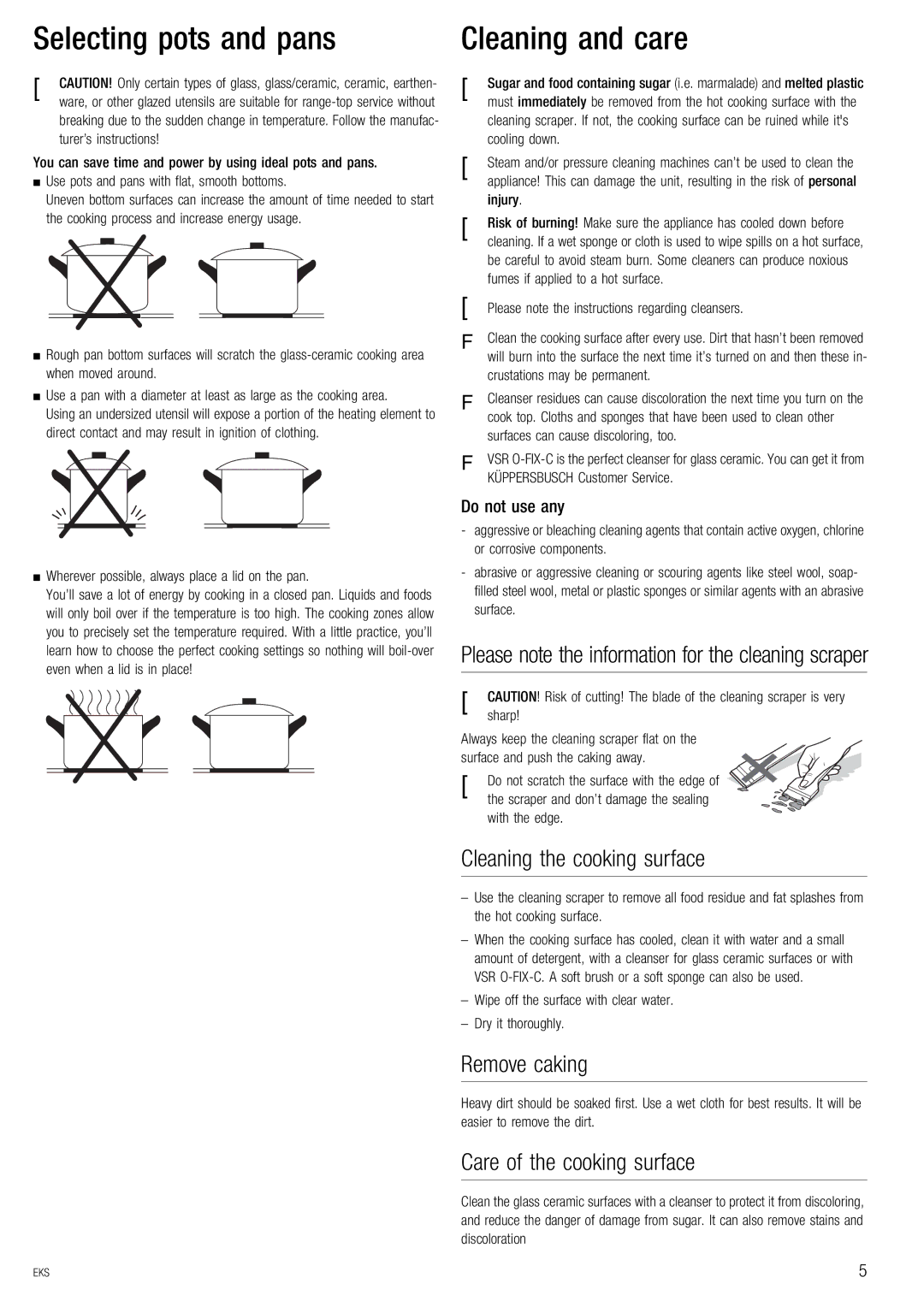
Selecting pots and pans | Cleaning and care |
[CAUTION! Only certain types of glass, glass/ceramic, ceramic, earthen- ware, or other glazed utensils are suitable for
breaking due to the sudden change in temperature. Follow the manufac- turer’s instructions!
You can save time and power by using ideal pots and pans.
■Use pots and pans with flat, smooth bottoms.
Uneven bottom surfaces can increase the amount of time needed to start the cooking process and increase energy usage.
■Rough pan bottom surfaces will scratch the
■Use a pan with a diameter at least as large as the cooking area.
Using an undersized utensil will expose a portion of the heating element to direct contact and may result in ignition of clothing.
■Wherever possible, always place a lid on the pan.
You’ll save a lot of energy by cooking in a closed pan. Liquids and foods will only boil over if the temperature is too high. The cooking zones allow you to precisely set the temperature required. With a little practice, you’ll learn how to choose the perfect cooking settings so nothing will
[Sugar and food containing sugar (i.e. marmalade) and melted plastic must immediately be removed from the hot cooking surface with the
cleaning scraper. If not, the cooking surface can be ruined while it's cooling down.
[Steam and/or pressure cleaning machines can’t be used to clean the appliance! This can damage the unit, resulting in the risk of personal
injury.
[Risk of burning! Make sure the appliance has cooled down before cleaning. If a wet sponge or cloth is used to wipe spills on a hot surface,
be careful to avoid steam burn. Some cleaners can produce noxious fumes if applied to a hot surface.
[Please note the instructions regarding cleansers.
ΦClean the cooking surface after every use. Dirt that hasn’t been removed will burn into the surface the next time it’s turned on and then these in-
crustations may be permanent.
ΦCleanser residues can cause discoloration the next time you turn on the cook top. Cloths and sponges that have been used to clean other
surfaces can cause discoloring, too.
ΦVSR
Do not use any
-aggressive or bleaching cleaning agents that contain active oxygen, chlorine or corrosive components.
-abrasive or aggressive cleaning or scouring agents like steel wool, soap- filled steel wool, metal or plastic sponges or similar agents with an abrasive surface.
Please note the information for the cleaning scraper
[CAUTION! Risk of cutting! The blade of the cleaning scraper is very sharp!
Always keep the cleaning scraper flat on the surface and push the caking away.
[ Do not scratch the surface with the edge of the scraper and don’t damage the sealing with the edge.
Cleaning the cooking surface
–Use the cleaning scraper to remove all food residue and fat splashes from the hot cooking surface.
–When the cooking surface has cooled, clean it with water and a small amount of detergent, with a cleanser for glass ceramic surfaces or with VSR
–Wipe off the surface with clear water.
–Dry it thoroughly.
Remove caking
Heavy dirt should be soaked first. Use a wet cloth for best results. It will be easier to remove the dirt.
Care of the cooking surface
Clean the glass ceramic surfaces with a cleanser to protect it from discoloring, and reduce the danger of damage from sugar. It can also remove stains and discoloration
EKS | 5 |
